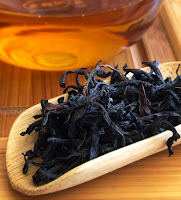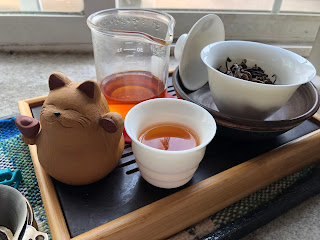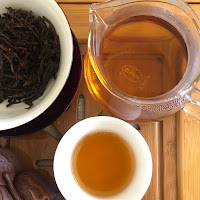Comparing a Tea to Itself: Wild Tree Purple Varietal Black Tea of Dehong
It's always interesting to compare a tea from two different harvests seasons AND to compare your own tea tastings. I only started keeping a tea tasting journal within the past few years, and my note taking style as changed, as has my tasting of tea. #teafiends
As I've learned more about tea, my journal has evolved to catalog slightly different things or to emphasis certain aspects of a tea. This also demonstrates my evolving tastes and what I deem important.
Here's a tea tasting of a Wild Tree Purple Varietal Black Tea of Dehong from Yunnan Sourcing --- the Spring 2012 and Spring 2020 harvests.
This is a expertly fermented black tea was crafted using a wild tree purple leaf varietal from Dehong prefecture. This wild tree varietal grows wild in the mountainous areas west of Mang Shi town in Dehong. Ye Sheng "野生“ varietal aka "Camellia sinensis (L.) Kuntze var. assamica (J. Masters) Kitam." (aka Dehongensis) is a primeval varietal that pre-dates Camellia Sinensis var. Assamica and is a naturally occuring non hybridized varietal. It's potency in cha qi arises from it's unadulterated nature. It is naturally bug repellent, grows wild in the forests of Yunnan at an altitude of 1600-2200 meters.
The aroma of tea is very strong and hints of eucalyptus and sugarcane. The mouth feel is incredibly complex and stimulating but never bitter or astringent. Ultra smooth tea that after a few months will develop even more complexity. Subtle but very noticeable cha qi and tranquil feelings.
An incredibly rare tea made entirely from first flush spring material.
My Notes of Spring 2012: Wild Tree Purple Varietal Black Tea of Dehong
Tasting date: 7/3/2019. I posted these notes on Steepster
Brew info: 5.25 grams of tea | 150 ml water | Porcelain gaiwan
This is my first time tasting purple tea, and I am very happy with the results. I brewed this Gong Fu (208 deg F at 15s, 30, 45…etc)
- The wet tea leaves smell of honey & raisins or molasses & plums/pluots with an undertone of minerals.

- The color is a beautiful orange amber that darkens with each subsequent steep until it begins to wash out.
- The broth is very smooth but complex. It starts off sweet on the tongue intermingled with a slight undercurrent of sourness that is pleasantly balanced out by the sweet. There are mild earth & malty flavors that don’t overpower the tea. If anything, this is a very well-balanced tea.
- Flavors: Earth, Honey, Malt, Mineral, Pleasantly Sour, Plums, Raisins
There’s a cha qi tingling on the tongue that goes straight to my head and relaxes the body. It’s got a wonderful mouthfeel, but it’s not that viscous. It’s quite an easy tea to drink. Despite having a clean/short finish, there is a lingering aftertaste of nectarines/peaches on the tongue
I’d be more than happy to drink more of this tea on a near daily basis if I didn’t have many other wonderful teas to drink.
Notes from Spring 2019: Wild Tree Purple Varietal
Tasting date: 2/15/2021Brew info: 6.13 grams of tea | 100 ml water | Porcelain gaiwan | Gong fu style (see steep information below)
The leaves are dark, and I love those dried purple leaves intermingled, hinting to the tea's wild side.
Leaf Aroma:
I like to smell the wet leaves in the gaiwan; both the lid (for the high notes) and inside the gaiwan for the low notes (as taught to me by Roy Fong, of the Imperial Tea Court)- The high notes of the wet leaves are sweet, but slightly sour
- The low notes from the wet leaves are of light smoke and cacao powder
The leaves open somewhat quickly. They seem to open up 7-10% with each steep. I think this tea will go on for a while.
Tea Broth / Soup:
- The color of the tea soup is a lovely orange amber
- The broth is very smooth with a very mild viscosity.
- There is hardly any astringency at all. I suspect this will be a very forgiving tea with regards to water temperature.
I don't detect the more fruity notes from 2012, which could be just the harvest year or my looking at tea differently.


Things to try next: I'd like to see if the "tang" will be reduced in a silver teapot, which does reduce the sourness in most Laoshans I've tried. Also, try in a Yixing pot to see if the flavor changes. I'll keep the 6 grams/ 100 ml ratio as I tend to like a high leaf / water ratio with most purple teas. I won't reduce the water temperature, as I like it as-is right now, but something worth experimenting with over time.
Brewing specs by steep:
- 200F @ 20s
- 200F @ 30s
- 195F @ 40s -- I wanted to see if the sourness/tang might be reduced with a lower temperature, but it didn't really.
- 200 F @ 40s -- still going fairly strong. The color of the soup hasn't changed much since the first, but I can tell it's just starting to drop. I figure I can go a decently long time with this tea as the leaves are not yet fully open.
- (5+ Steeps) Flavors are diminishing very slowly over time, as is the color of the soup. The tang is also dropping, but the slight sweet is still there. Still keeping itself balanced.
Figure: First 4 steeps


Summary of the 2019 Harvest:
This tea has a nice quiet feeling. It's not a "warming" feeling like some more malty teas (like a Jin Jun Mei), but it's got a nice mild cha qi. It strikes a nice balance between sweet & sour,
I like this tea, but I also tend to like purple teas made from the Ye Sheng Varietal as I like "purple" flavor, with its tangy notes that are balanced by the rest of the red tea. This tea doesn't have the "malty" notes of some red / black teas, but it does have hints of cocoa powder. (If you don't like a slight "tang" or "sour" note to your tea, this might not be your cuppa.)
It'll be a good daily drinker for me for those longer meeting days.




Comments
Post a Comment